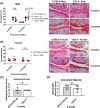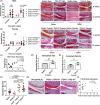TSG-6 Is Weakly Chondroprotective in Murine OA but Does not Account for FGF2-Mediated Joint Protection
- PMID: 33029956
- PMCID: PMC7571392
- DOI: 10.1002/acr2.11176
TSG-6 Is Weakly Chondroprotective in Murine OA but Does not Account for FGF2-Mediated Joint Protection
Abstract
Objective: Tumor necrosis factor α-stimulated gene 6 (TSG-6) is an anti-inflammatory protein highly expressed in osteoarthritis (OA), but its influence on the course of OA is unknown.
Methods: Cartilage injury was assessed by murine hip avulsion or by recutting rested explants. Forty-two previously validated injury genes were quantified by real-time polymerase chain reaction in whole joints following destabilization of the medial meniscus (DMM) (6 hours and 7 days). Joint pathology was assessed at 8 and 12 weeks following DMM in 10-week-old male and female fibroblast growth factor 2 (FGF2)-/- , TSG-6-/- , TSG-6tg (overexpressing), FGF2-/- ;TSG-6tg (8 weeks only) mice, as well as strain-matched, wild-type controls. In vivo cartilage repair was assessed 8 weeks following focal cartilage injury in TSG-6tg and control mice. FGF2 release following cartilage injury was measured by enzyme-linked immunosorbent assay.
Results: TSG-6 messenger RNA upregulation was strongly FGF2-dependent upon injury in vitro and in vivo. Fifteeen inflammatory genes were significantly increased in TSG-6-/- joints, including IL1α, Ccl2, and Adamts5 compared with wild type. Six genes were significantly suppressed in TSG-6-/- joints including Timp1, Inhibin βA, and podoplanin (known FGF2 target genes). FGF2 release upon cartilage injury was not influenced by levels of TSG-6. Cartilage degradation was significantly increased at 12 weeks post-DMM in male TSG-6-/- mice, with a nonsignificant 30% reduction in disease seen in TSG-6tg mice. No differences were observed in cartilage repair between genotypes. TSG-6 overexpression was unable to prevent accelerated OA in FGF2-/- mice.
Conclusion: TSG-6 influences early gene regulation in the destabilized joint and exerts a modest late chondroprotective effect. Although strongly FGF2 dependent, TSG-6 does not explain the strong chondroprotective effect of FGF2.
© 2020 The Authors. ACR Open Rheumatology published by Wiley Periodicals LLC on behalf of American College of Rheumatology.
Figures





References
-
- Milner CM, Day AJ. TSG‐6: a multifunctional protein associated with inflammation. J Cell Sci 2003;116:1863–73. - PubMed
-
- Tammi MI, Day AJ, Turley EA. Hyaluronan and homeostasis: a balancing act. J Biol Chem 2002;277:4581–4. - PubMed
-
- Day AJ, Milner CM. TSG‐6: A multifunctional protein with anti‐inflammatory and tissue‐protective properties. Matrix Biol 2019;78–79:60–83. - PubMed
Grants and funding
LinkOut - more resources
Full Text Sources
Research Materials
Miscellaneous

